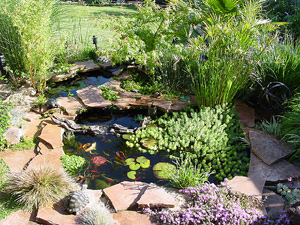Maintaining Your Pond

Your pond requires special maintenance with each season. Below is a guide of what should be done to keep your pond environment at its best throughout the seasons.
Spring
- Life returns to your pond in the Spring. Your fish are still lethargic. Do not feed them until the water reaches 40° F or above for a week straight. They are unable to digest food if they are fed then forced into hibernation by sudden cold spells. Feed your fish easily digestible wheat germ rich foods (low protein). Feed at midday when fish activity is at its most.
- Keep pond covered by a net until marginal plants grow and while fish are still lethargic-so hungry Herons and King Fishers do not empty your pond of fish.
- After removing net clean back dead plants and foliage. Remove leaves from the pond bottom, decomposing leaves become stressful to fish. It is advisable to carry out a partial water change add Aquasafe or Chloramine to reduce Chlorine, ammonia & heavy metals. This freshens up your pond.
- Check all electrical equipment. Clean intakes of pump and check cable.
- Turn on Bio-filter (rinse all parts), when temp reaches 40°F. Add clear Pond bio-organisms daily to bio-filter for quicker start-up of bio-filter.
Early Summer
- Net out or pull out thread algae which flourish this time of year. Your pond will be green until your plants start to shield the surface. If this green pea soup drives you crazy you may consider investing in a bio-filter. A properly sized and maintained bio-filter will clear water within a few weeks.
- Fertilize your plants monthly and divide any plants which may be overgrowing their containers.
- Fish will be feeding more now and can be given higher protein food. Keep an eye on your fish health as this time warm weather also breeds parasites.
- Bio-filters are under great stress at this time Bio-organisms are unable to reproduce enough to cope with increased fish waste and increased algae growth
- Clean pre filters regularly to prevent clogging.
Mid to Late Summer
- Your pond is at its best. Their may be times when water levels drop significantly and more frequent topping may be required.
- Oxygen levels may drop, your pond life will benefit from pumps being run all day and night.
- You can still introduce or divide plants.
- Monthly maintenance of bio-filter, flushing and clean intake of pumps for clogs. You will notice significant reduction in flow if you have a serious clog. This will reduce the life and efficiency of your pump if not cleaned occasionally. Small filters in ponds must be rinsed 2 to 3 times per week. Remember to rinse small and large filter pads in a bucket of pond water to prevent the elimination of beneficial bio-organisms. Chlorine in city water kills bio-organisms.
Autumn
- Tidy up pond, trim back dying plants. Lower lilies to bottom of pond, cut back. Trim back oxygenating plants and replant. Early autumn is the last possible time to consider a complete pond clean out. Otherwise, change 20% of the water to refresh the pond. remove as much waste from the bottom of pond as possible.
- Cover the pond with netting to prevent leaf pollution.
- Examine fish for any signs of disease. Do not move fish or introduce new ones when temperatures reach 10°C/ 50°F. See winter section for pump replacement.
- Give filters a good cleaning before winter sets in.
Winter
- Fish enter a state of semi-hibernation at temperatures below 40°F. Moving very slowly in the depths of the pond. Refrain from feeding fish until the spring. During the short mild spells of winter the fish will find natural food.
- Leave pond cover or nets in place.
- If your pump is placed at the bottom of the pond, you must move it slightly below the surface. The ideal situation is to only stir the surface water if you plan on running your pump through the winter. You should use a smaller pump in the winter to stir surface. If you have a separate smaller pump for your bio-filter use that. Keeping the surface moving will prevent the pond from freezing.
- If the surface is allowed to freeze for more than two days fresh oxygen is prevented from entering the water and waste gasses are prevented from exiting.
- You can do the following to melt the ice:
- Melt a hole in the ice by boiling water and placing hot pan bottom on the ice.
- Plug in commercially purchased pond heater which senses temperature change.
- Keep a pump running all winter significantly reduced volume, moving water does not freeze.
- Do Not break the ice, shock waves stun or kill fish!

Home | Planning Your Pond | Equipment | Construction | Water Plants | Preparing for Fish
Fish & Other Pond Life | Maintaining Your Pond | FAQs | Contact Us
|


